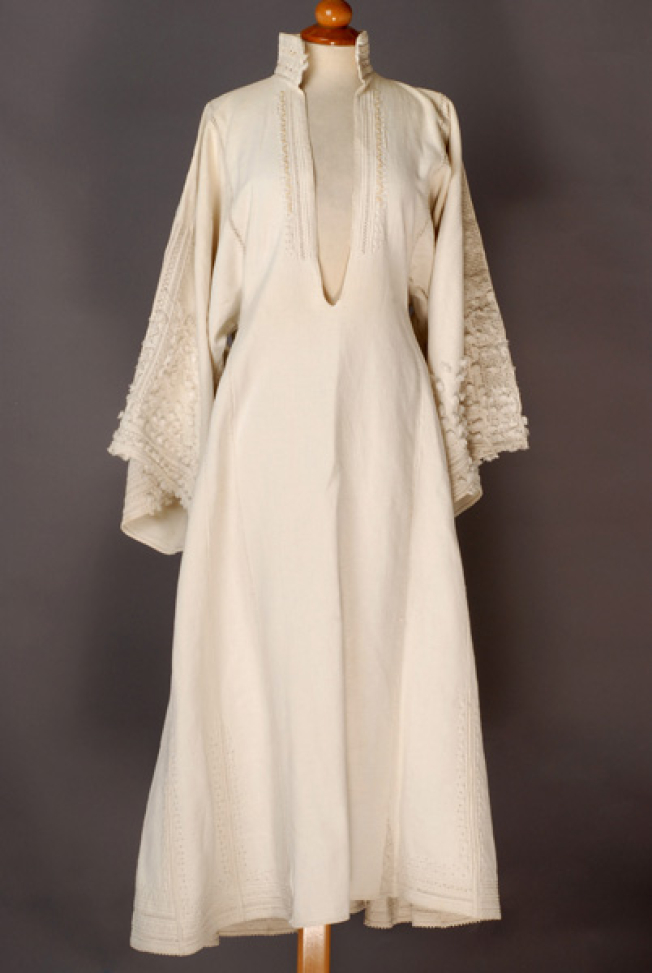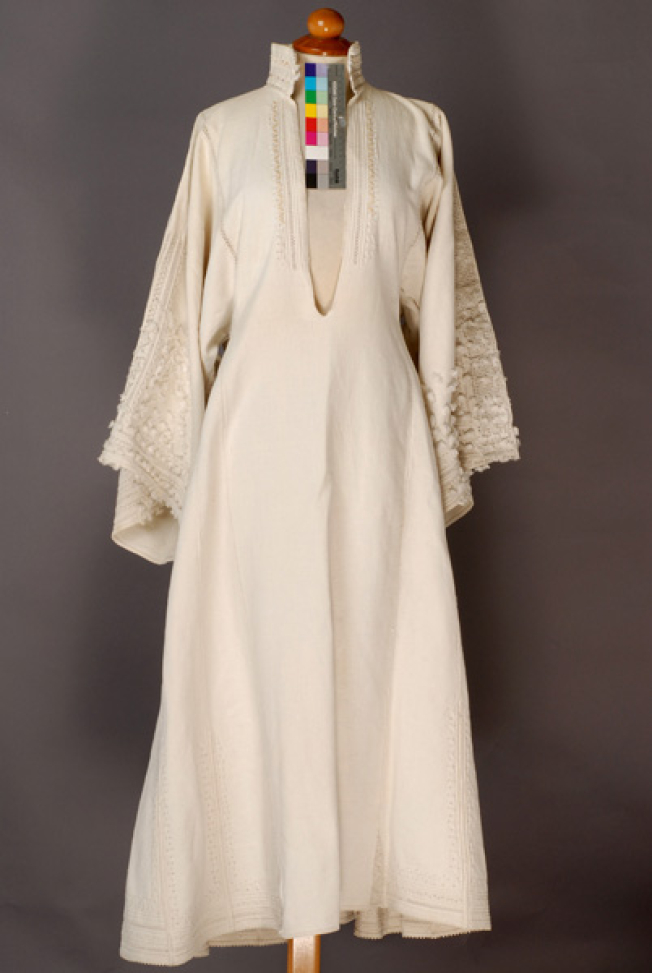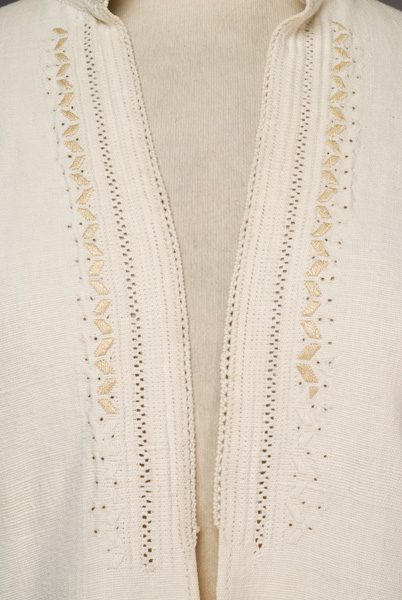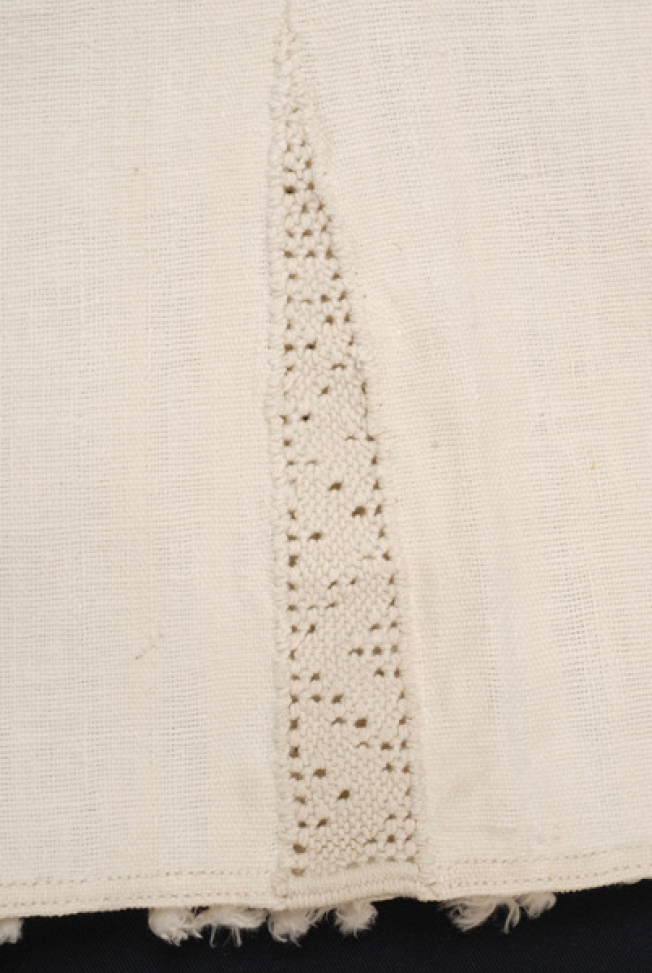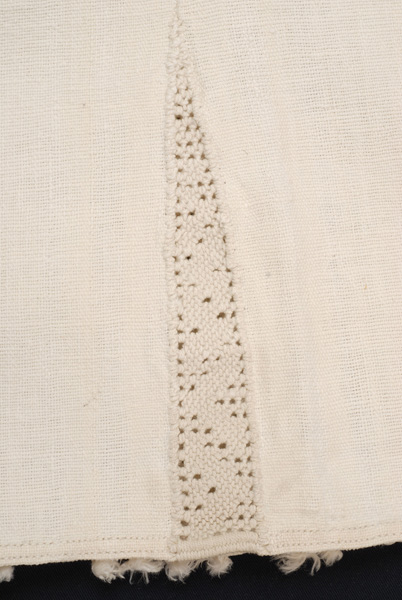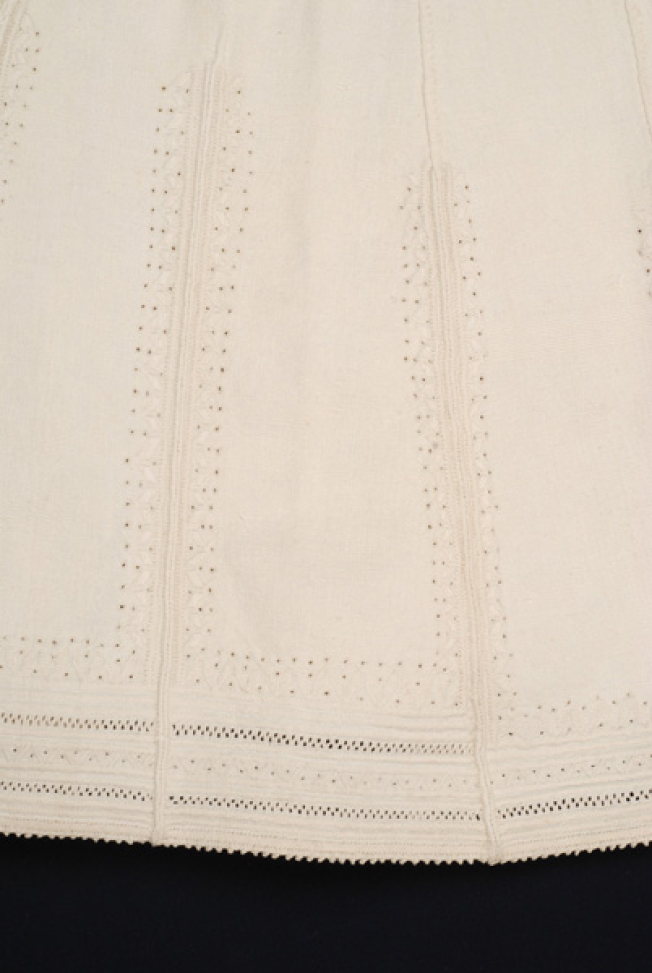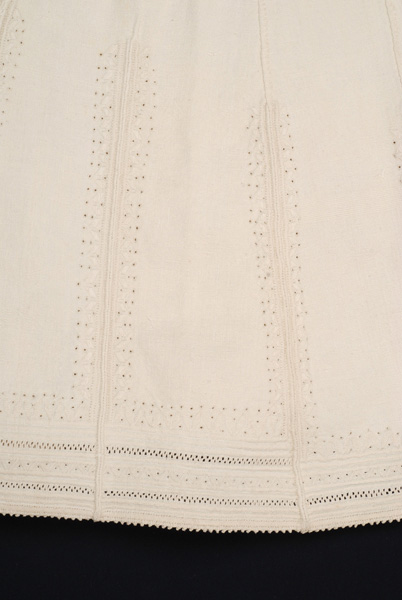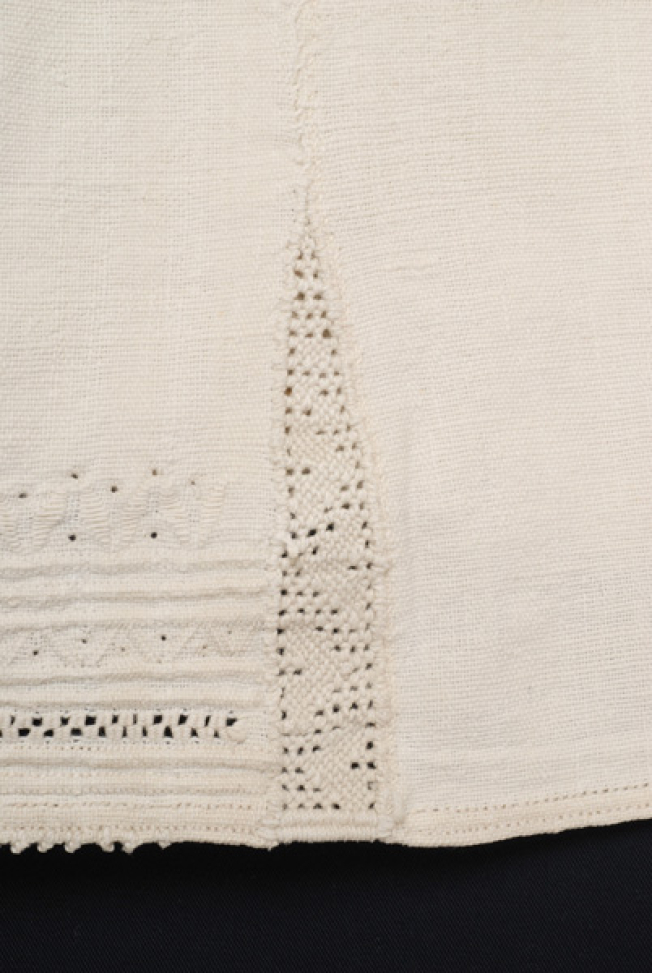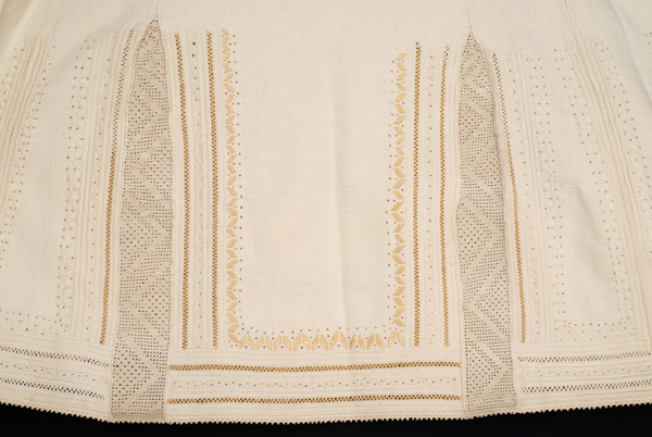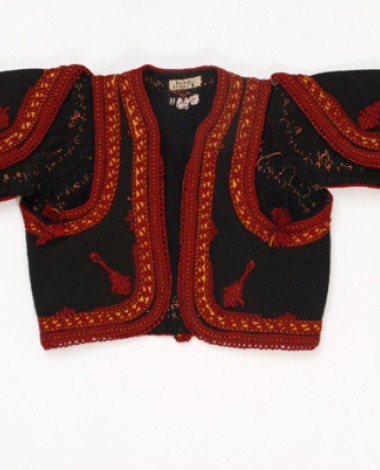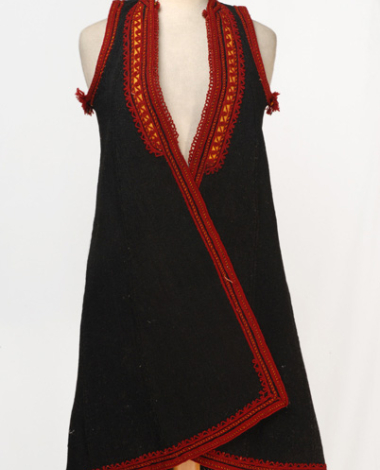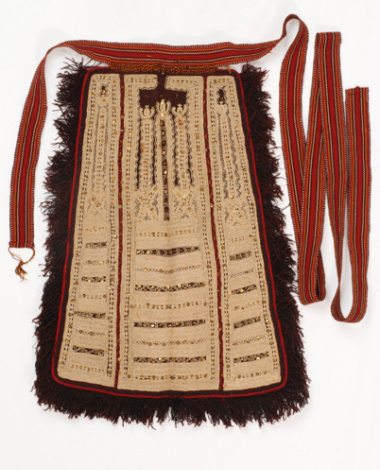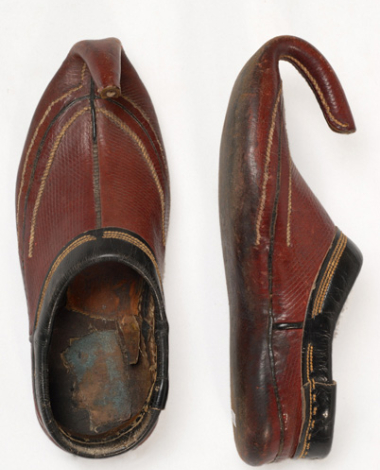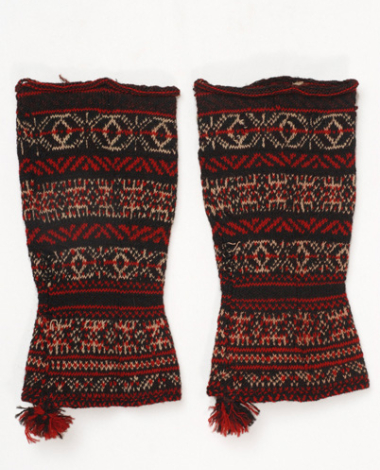chemise
1042/1,α
Detail of the embroidered decoration at the collar
Detail of the embroidered decoration at the sleeve: seradi, decorative themes and small tassels.
Detail of the decoration at the sleeve: small seradi at the lower seam
Detail of the embroidered decoration at the border (lagkiolia)
Detail of the embroidered decoration at the border: small seradi at the front joint with mana
Object Identity
Object ID Number
1042/1,α
Object name
chemise
Other / Local name
routi or po(u)kamiso
Style
peasant, costume with sigouni (sleeveless woollen coat)
Production date range
end of 19th century
Production date (circa)
1870-1890
Part of outfit
Yes
Physical Description
Description
Ρουτί ή πο(υ)κάμισο, γυναικείο, ποδήρες πουκάμισο από λευκό, αγοραστό, βαμβακερό ύφασμα (χοντροπάνι ή κατσαροπάνι). Αποτελείται από τη μάνα, ένα ίσιο φύλλο υφάσματος μπρος - πίσω, χωρίς ραφή στους ώμους, και έξι λαγκιόλια, επιμήκη τραπεζοειδή τμήματα, σε κάθε πλευρά, από τη μέση και κάτω, που δίνουν φάρδος στο ένδυμα. Φέρει γιακά και κατακόρυφο άνοιγμα μπροστά, ύψους 35εκ. Κάθετα στον κορμό είναι ραμμένα τα μανίκια, μήκους 56εκ. και φάρδους 45εκ. Τα παλαιά, όπως αυτό, ρουτιά έχουν δίφυλλα μανίκια, ενωμένα με σεράδι (κεντητή ένωση καμωμένη με το βελόνι) στην πάνω πλευρά και με ραφή στην κάτω. Το ρουτί φέρει πλούσια κεντητή διακόσμηση στο γιακά, τα μανίκια, το κατακόρυφο μπροστινό άνοιγμα και τον ποδόγυρο. Ο γιακάς και τα μανίκια ενώνονται με τη μάνα με
κεντητές ενώσεις καμωμένες με υπόλευκη βαμβακερή κλωστή. Ο γιακάς φέρει κεντητές ζώνες αζούρ (λευκούλα) και κοφτό εναλλάξ. Οι κύκλοι που δημιουργούνται στο κοφτό (φακίτσες) είναι διακοσμημένοι με κίτρινη και σκούρα ροζ μεταξωτή κλωστή και τοποθετημένοι σε ζικζακωτή διάταξη. Τέσσερα βαμβακερά λευκά φουντάκια διακοσμούν κάθε κατακόρυφη πλευρά του. Το άνοιγμα του στέρνου φέρει από έξω προς τα μέσα τα εξής διακοσμητικά θέματα: άλυσος, αράδες, λευκούλα, πανωπούλια και φακίτσες, καμωμένα με μπεζ και λευκές μεταξωτές κλωστές και βελονιά πλακέ τα εξωτερικά και με λευκή βαμβακερή τα εσωτερικά. Τα μανίκια δίπλα στο σεράδι φέρουν τα εξής θέματα: λευκούλα, βούλα, λευκούλα, αράδα και φακίτσες. Στο γύρο του μανικιού τα θέματα αυτά επαναλαμβάνονται οριζόντια. Φουντίτσες βαμβακερές κοσμούν την κάτω εξωτερική πλευρά του μανικιού σχηματίζοντας ένα μεγάλο τραπέζιο. Στην κάτω ραφή υπάρχει επίσης ένα μικρό σεράδι. Στον ποδόγυρο, τα θέματα αυτά διακοσμούν το γύρο και τις κατακόρυφες ενώσεις των λαγκιολιών σε ύψος 32εκ. περίπου. Οι μπροστινές ενώσεις της μάνας, καθώς καλύπτονται από την ποδιά, φέρουν μόνο ένα μικρό τριγωνικό σεράδι. Αντίθετα, οι πίσω ενώσεις φέρουν τριγωνικό σεράδι ύψους 43εκ. Τα κεντήματα στο πίσω τμήμα της μάνας είναι καμωμένα και αυτά με μπεζ μεταξωτή κλωστή.
Decoration & Patterns
Decoration
geometric decoration
Decorative patterns / subjects
-
Height
1.300
Width
0.360
Production
Maker / Designer / Brand
women themselves
Production date range
end of 19th century
Production date (circa)
1870-1890
Production place (Country | Geographic Area | Prefecture & Region)
Greece |
Epirus |
Thesprotia
Paramythia
Material
cotton
cotton thread
silk thread
Techniques
embroidered band,
needle point lace
embroidery,
flat stitch
embroidery,
hem stitching
handwoven fabric
Use
User
woman
Occasion
festive
Date range
end of 19th century
Date (circa)
1870-1890
Place of use (Country | Geographic Area | Prefecture & Region)
Greece |
Epirus |
Thesprotia
Paramythia
Acquisition
Acquisition method
Untraced Find
Publications
Object publication history
Documentation
Research bibliographic references
Image license
Use the file or the thumbnail of the image according to the license:
CC BY-NC-ND 4.0
Attribution-NonCommercial-NoDerivatives





